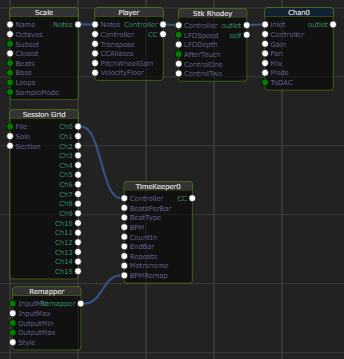/ Examples / Control / Session Grid
NoteStreams .. Instruments
Filters .. Effects .. LiCK Effects
Plot .. Utility .. Pure ChucK
Wherein we demonstrate the raw power of Session Grids. Right-click to copy this example to your workspace
Theory of Operation
A Session Grid is be used to schedule or trigger downstream notestreams
like NoteGrid. It can play a role
analogous to the Timeline or Session View in most DAWs. The
Grid Editor is used to produce
the session grid files that drive the Session Grid node.
This example offers you two projects for the price of one. The first, Tempo Session introduces the basic capabilities of a Session Grid. The second The Challenge is a sort of Rube Goldberg Machine intended to confuse, amaze, amuse. Your challenge is to understand its functional components.
Tempo Session
Here's the graph, tempoSession.chg. The top row is a run-of-the-mill
notestream-based synthesis subgraph. Below that, the SessionGrid node
is delivering messages to control the TimeKeeper
in a fashion similar to that presented in this example.

The SessionGrid node's File parameter is set to tempoSession.fgrd shown
below. This file has a single cell with a duration of 21 measures.
Within that cell you can see a reddish graph of the BPMPct. In the
right sidepanel we see that BPMPct is both visiable and drawable and
this means that you can use your mouse to "draw" the tempo changes for
this session. Having drawn this nice picture, you might wonder what range
of tempos does this graph represent? This question is answered by inspecting
the Remapper node where you'll find that
we remap the graph range [0, 1] onto real BPM values [100, 200].
When you perform this graph you can follow-along in the Grid Editor and watch the tempo evolve. Easy as pi.

Extra credit:
- As described elsewhere the SessionGrid cells are "decoupled" from the graph timing. They do share the same timekeeping but here, you'll note that the Scale completes before the end of the BPM cell. It's simple to bring them into conformance by editing the cell duration in the Grid Editor.
- If you find that need more or less event-resolution in a cell you
can
right-clickon it and requestResample. Note that this only applies to the active subevent channel. - You can add comments to your Session Grid. Just activate (or create)
a
Comments Layerand create a comment cell. When selected, theCell Paneloffers a text entry field. Now, when you hover the mouse over the area occupied by comment cells you'll see your comments presented in a transitory tool-tip. This hover behavior applies even when the comments are hidden by the layer-visibility knob. If you don't like the tooltips, they can be disabled in theLayer Panel Menu.
The Challenge
The files, theChallenge.chg and theChallenge.fgrd form the foundation
of this challenge which is merely to understand how this Rube Goldberg
machine works. Most session files aren't this crazy but understanding
this one fully will sharpen your Session-Grokking
skills. Here are some tools and techniques to help you in this quest:
SessionGridallows you to solo a layer.Commentsare included intheChallenge.fgrdin many places. Just hover over the cells in question.- Other aspects of the behavior are locked up in
scale.fgrdanddiag.fgrd. Specifically, these files may containsectionsand their associatedNoteGridfile may interpret incomingProgramevents as section changes. - Individual sound files can be auditioned in the Sound Player.
First you must locate the Graph Node that references the sound file, then
click on the
view/editicon next to its filename. - You can audition a portion of a SessionGrid by creating/selecting a
Sectionand entering its id into the SessionGrid node. - You can hide/show individual subevent channels in the
Layers Panelof the Grid Editor. You can also change the colors to make important events stand out.

